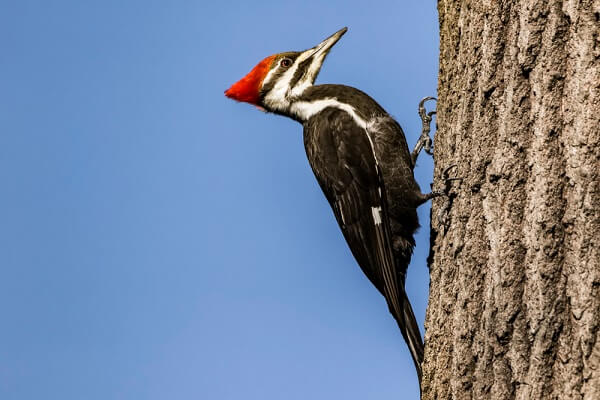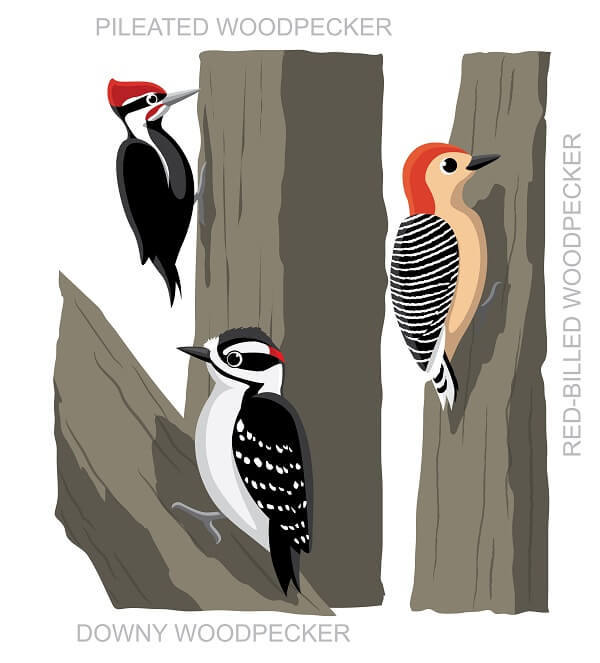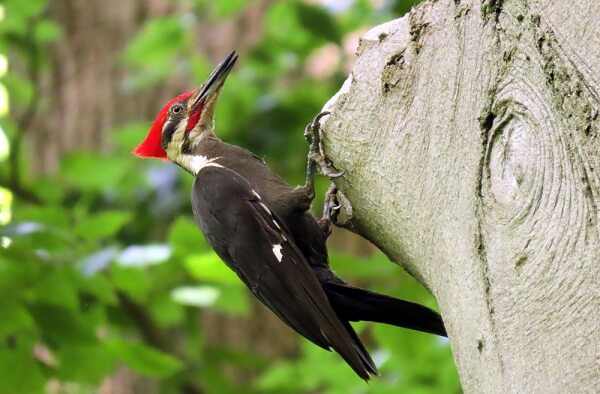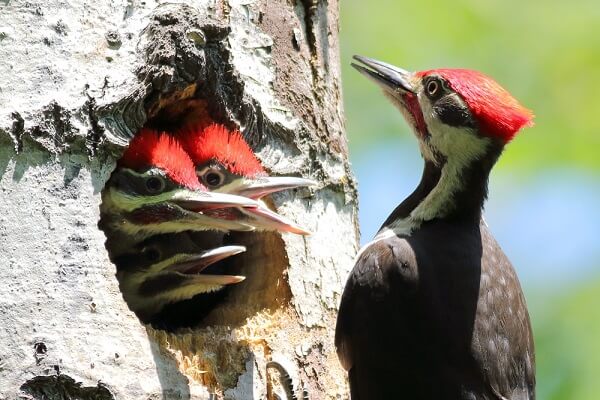
The Pileated Woodpecker has a prominent red crest in both males and females. Like other woodpeckers, the pileated woodpecker relies on its powerful claws to grip trees while boring into the wood with its sharp beak. These birds feed mainly on the insects that eat dead wood – including carpenter ants, beetle larvae, termites, and other boring insects. Pileated woodpeckers are capable of creating massive cavities in dead trees. Aided by the boreholes of the insects they are hunting, they can easily turn a solid tree into a pile of wood shavings in only a few days. Pileated woodpeckers typically only bore into trees that have already been infested by ants, termites, or beetle larvae – though they do sometimes cause damage to houses, cars, and other human property. The pileated woodpecker saw a gradual decline before the 1900s, and many woodpecker species even went extinct as the human population expanded across North America. However, since the early 1900s, it seems that the pileated woodpecker is making a comeback. On average, the population expands at about 1.5% a year and its range is slowly expanding into parts of Canada and the United States. Interestingly, many other bird species will use woodpecker roosts after this species is finished with it. This means that woodpeckers are very important for the entire forest ecosystem they inhabit! Though the pileated woodpecker is a magnificent species to watch in the wild, the species actually has a lot to teach us about biology! In fact, these birds are actually excellent examples of several different biological concepts. Think about the evolution of insects and woodpeckers. The wood found in trees is hard, and the nutrients in that wood are not easily accessible. However, many insects find refuge in dead trees eating the wood and living without direct contact with predators. Woodpeckers have adapted specifically to exploit this defense mechanism. With their sharp beaks and ability to hit the wood repeatedly, they can find the weak spots where insects have already bored out the wood. The ancestors of woodpeckers may have been like smaller finches that simply pick insects from the outer bark layers of wood. But, birds with bigger beaks and a stronger impact strikes were able to dig further into the trees in search of boring insects. Eventually, you get the pileated woodpecker. These birds are such capable carvers that they can easily form cavities large enough to build a nest in. With these adaptations, the woodpeckers are able to find a consistent supply of food and raise their young away from ground predators. In the Animal Kingdom, there are a thousand and one ways to attract a mate. Some animals collect shiny objects, others fight to attract mates, and some animals build the perfect home. Pileated woodpeckers fall in this last category. The male will spend weeks excavating the perfect roost in a dead tree. Males try to select the biggest trees they can find to create the ultimate nesting site. Typically, a pileated woodpecker roost will contain several entrances, making it a grand abode for up to 5 offspring. Females pick their mates based on the best roost – so size and location are both very important. Once the female picks her mate, they will work together to line the roost with soft materials suitable for a nest and the female will lay 3-5 eggs. Once hatched, the babies are loud and will often stick their heads out of the entrance to be first in line to receive some regurgitated insects from the parents.
Kingdom
Animalia
Phylum
Chordata
Class
Aves
Order
Piciformes
Family
Picidae
Genus
Dryocopus
Species
Dryocopus pileatus
Niche
Wood-boring Insectivore
Length
16-19 in (40-49 cm)
Weight
8-14 oz (250-400 g)
Lifespan
Up to 12 years
Social Structure
Mated Pairs
Conservation Status
Least Concern
Preferred Habitat
Wooded areas with plenty of wood-boring insects
Average Clutch Size
3-5 eggs
Main Prey Species
Carpenter ants, beetle larvae, other insects, sometimes fruit and nuts
Predators
Hawks, Owls, Eagles, Martens, Weasels, Humans
The Basics

Interesting Insights from the Pileated Woodpecker!
Predator/Prey Evolution Dynamics

Attracting Mates

